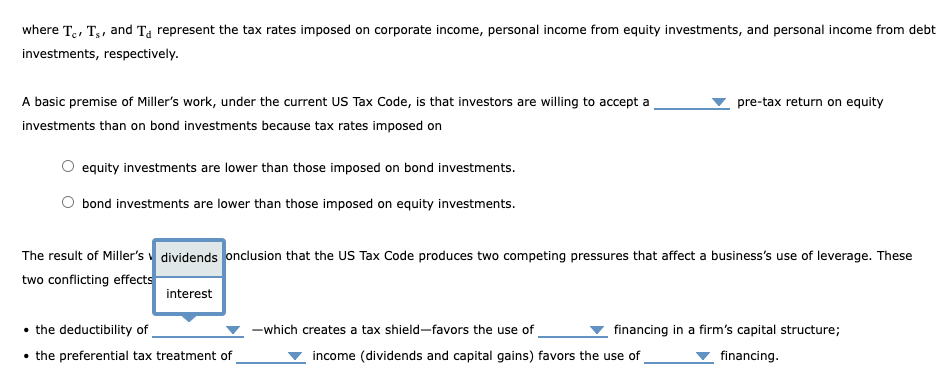Answered step by step
Verified Expert Solution
Question
1 Approved Answer
The last 3 blanks are (debt/equity) 7. The effect of taxes Modgliani and Miller Proposition I with Taxes Debt financing has one important advantage that





The last 3 blanks are (debt/equity)
7. The effect of taxes Modgliani and Miller Proposition I with Taxes Debt financing has one important advantage that the early Modigliani and Miller (MM) propositions ignored: the interest on business debt is tax deductible. This benefit means that the amount of taxes that a business is required to pay will be reduced by a phenomenon called an interest tax shield, which is a function of the amount of debt in the firm's capital structure and its tax rate. In contrast, the dividends that a corporation pays on its common and preferred shares are not tax deductible. Consider the case of Orange Goose Foodstuffs, Inc.: At the beginning of the year, Orange Goose Foodstuffs, Inc. had an unlevered value of $9,000,000. It pays federal and state taxes at the marginal rate of 40%, and currently has $3,000,000 in debt capital in its capital structure. According to MM Proposition I with taxes, Orange Goose Foodstuffs is allowed to recognize a tax shield of the firm is , and the levered value of $10,200,000. O $7,800,000. O $12,000,000. O $6,000,000. In 1977, Merton Miller added to the discussion regarding the effect of taxes on a firm's value by including the effect of personal income taxes. He was interested in how the presence of individual income taxes would affect business's use of debt financing, and developed the following model for the value of a levered firm: VL = V. +D [1 - 4-T.) (-1) (1-T) where T., Ts, and Ta represent the tax rates imposed on corporate income, personal income from equity investments, and personal income from debt investments, respectively. pre-tax return on equity A basic premise of Miller's work, under the current US Tax Code, is that investors are willing to accept a investments than on bond investments because tax rates imposed on O equity investments are lower than those imposed on bond investments. bond investments are lower than those imposed on equity investments. The result of Miller's work is the conclusion that the US Tax Code produces two competing pressures that affect a business's use of leverage. These two conflicting effects are the deductibility of -which creates a tax shield-favors the use of financing in a firm's capital structure; income (dividends and capital gains) favors the use of financing. the preferential tax treatment of At the beginning of the year, Orange Goose Foodstuffs, Inc. had an unlevered value of $9,000,000. It pays federal and state taxes at the marginal rate of 40%, and currently has $3,000,000 in debt capital in its capital structure. , and the levered value of According to MM Proposition I with taxes, Orange Goose Foodstuffs is allowed to recognize a tax shield of the firm is $1,200,000 O $10,200,000. $1,080,000 O $7,800,000. $840,000 O $12,000,000. $1,920,000 O $6,000,000. In 1977, Merton Miller added to the discussion regarding the effect of taxes on a firm's value by including the effect of personal income taxes. He was interested in how the presence of individual income taxes would affect business's use of debt financing, and developed the following model for the walue of a levered firm: pre-tax return on equity A basic premise of Miller's work, under the current US Tax Code, is that investors are willing to accept a investments than on bond investments because tax rates imposed on lower a equity investments are lower than those imposed on bond investments. greater bond investments are lower than those imposed on equity investments. The result of Miller's work is the conclusion that the US Tax Code produces two competing pressures that affect a business's use of leverage. These two conflicting effects are the deductibility of the preferential tax treatment of -which creates a tax shield-favors the use of financing in a firm's capital structure; income (dividends and capital gains) favors the use of financing where Tc, Ts, and Ta represent the tax rates imposed on corporate income, personal income from equity investments, and personal income from debt investments, respectively. pre-tax return on equity A basic premise of Miller's work, under the current US Tax Code, is that investors are willing to accept a investments than on bond investments because tax rates imposed on equity investments are lower than those imposed on bond investments. bond investments are lower than those imposed on equity investments. The result of Miller's dividends onclusion that the US Tax Code produces two competing pressures that affect a business's use of leverage. These two conflicting effects interest the deductibility of the preferential tax treatment of -which creates a tax shield-favors the use of financing in a firm's capital structure; income (dividends and capital gains) favors the use of financing. pre-tax return on equity A basic premise of Miller's work, under the current US Tax Code, is that investors are willing to accept a investments than on bond investments because tax rates imposed on equity investments are lower than those imposed on bond investments. bond investments are lower than those imposed on equity investments. The result of Miller's work is the conclusion that the US Tax Code produces two competing pressures that affect a business's use of leverage. These two conflicting effects are debt the deductibility of the preferential tax treatment of equity h creates a tax shield-favors the use of financing in a firm's capital structure; income (dividends and capital gains) favors the use of financingStep by Step Solution
There are 3 Steps involved in it
Step: 1

Get Instant Access to Expert-Tailored Solutions
See step-by-step solutions with expert insights and AI powered tools for academic success
Step: 2

Step: 3

Ace Your Homework with AI
Get the answers you need in no time with our AI-driven, step-by-step assistance
Get Started


